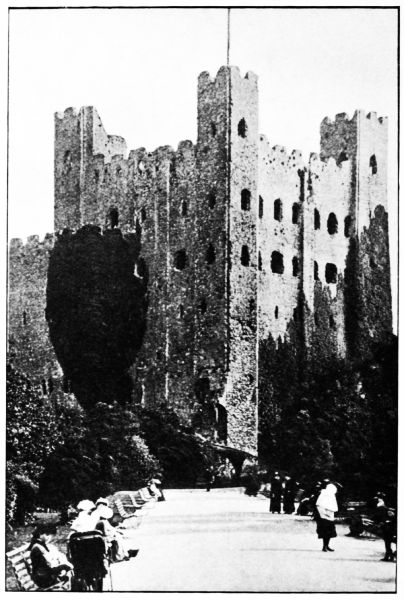The cover image was created by the transcriber and is placed in the public domain.
MILITARY ARCHITECTURE INENGLAND DURING THE MIDDLE AGES

Frontispiece
ROCHESTER: GREAT TOWER.
MILITARY ARCHITECTUREIN ENGLAND DURING THEMIDDLE AGES
BY
A. HAMILTON THOMPSON
M.A., F.S.A.
Illustrated by 200 Photographs, Drawings, and Plans
HENRY FROWDE
OXFORD UNIVERSITY PRESS
LONDON, NEW YORK, TORONTO, AND MELBOURNE
1912
Printed at
The Darien Press
Edinburgh
PREFACE
Apart from the late Mr G. T. Clark’s Mediæval Military Architecture,published in 1884, the greater portion of which is a series ofmonographs dealing with individual castles, there has been no attempt,until within the last few years, to apply systematic treatment tothis branch of science. Recently, however, more than one book hasbeen published upon the general subject of the castles of England.Mr Alfred Harvey has lately given a lucid account of the growth ofthe castle, with a valuable essay upon English walled towns; and thepresent year has seen the appearance of a book in which Mrs Armitagehas embodied the result of labours of the utmost importance, extendingover many years. In addition to works of a general character, anumber of separate monographs, indispensable to students, have beenpublished during the last twenty years, in the transactions of variousarchæological societies. The contributions of Mr W. H. St John Hope tothe study of castle architecture take a foremost place among these,with papers such as those by Mr J. Bilson on Gilling castle and byMr Harold Sands on Bodiam and the Tower of London; and the late MrCadwallader Bates’ unfinished Border Holds of Northumberland containsaccounts of Warkworth and Bamburgh, as well as of smaller castles andpeles, which must take rank among the classics of the subject.
In the present volume an attempt is made to trace the growth of thegeneral principles of medieval fortification, with special referenceto castles, in which, within their limited area, the most completeillustration of those principles is given. In order to give greaterclearness to the account of their evolution, a prefatory chapter dealsgenerally with earlier types of fortification in Britain, and thecritical period of Saxon and Danish warfare is treated in the secondchapter with some detail. This leads us to the early Norman castle ofearthwork and timber; and the stone fortifications to which this gaveplace are introduced by a brief account of the progress of siegecraftand siege-engines. The Norman castle and its keep or great tower arethen described. The developments of the later part of the twelfthcentury and the arrangements of the thirteenth-centuryviii castle, withthose of the dwelling-house within its enceinte, follow and preparethe way for the castles of the reign of Edward I. which representthe highest effort of military planning. In the last two chaptersis related the